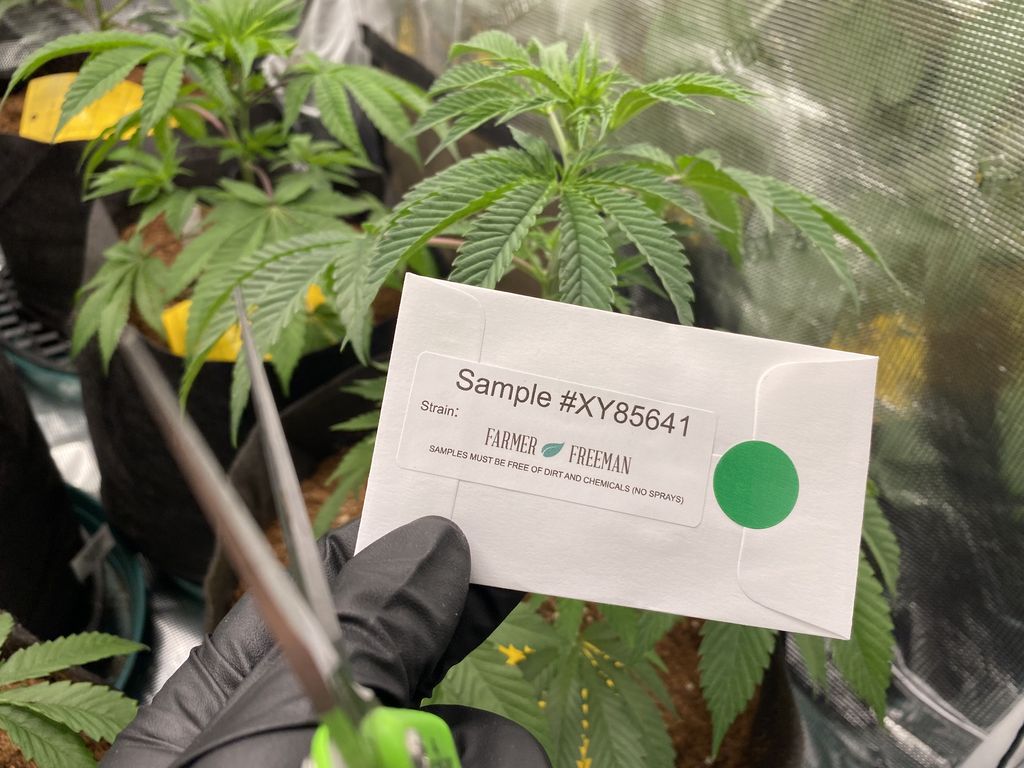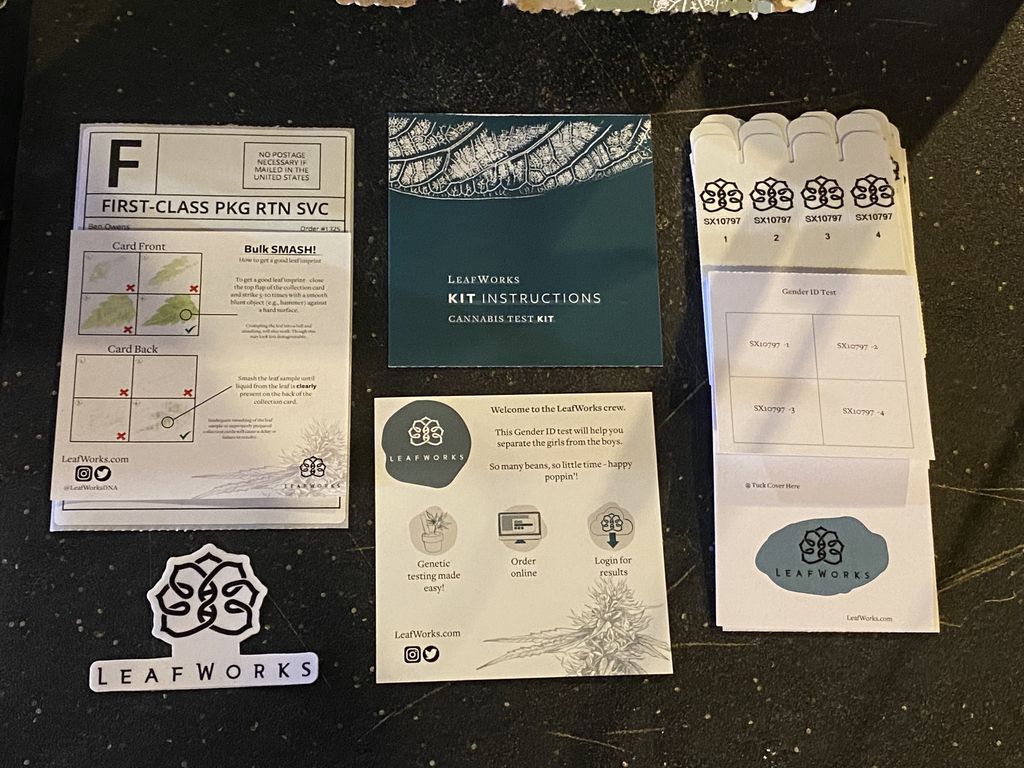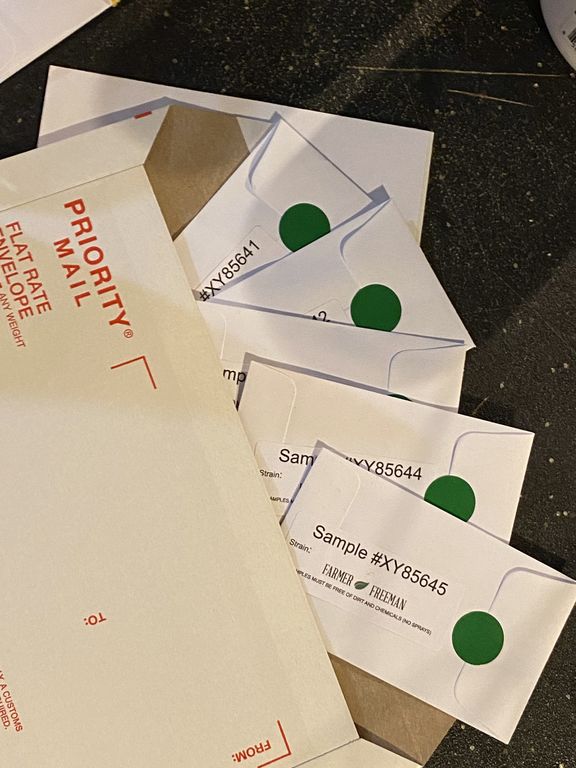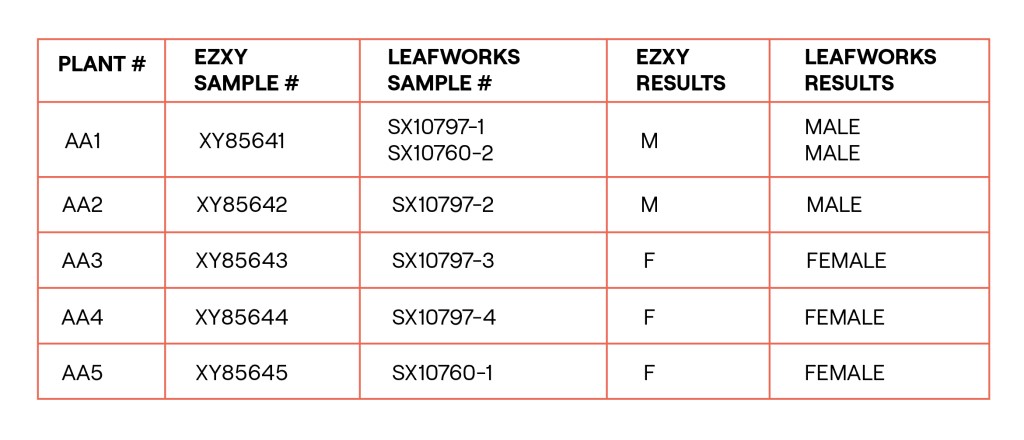Sexing M/F Genetics: Using Mail-In Tests
If you’re growing from M/F seeds (or you aren’t sure whether the seeds you have are feminized or not), there’s the potential that you may end up with a few males.
Depending on your end game, you may want those males. If you plan to make seeds, a male might be something you’re looking for. But for most growers, males typically get culled as soon as they’re detected for risk of pollination.

How do you know if you’ve got a male plant?
There are three ways to identify the gender of a seedling:
1. Flip it to flower
Seedlings have to develop ethylene to begin to flower (typically 5-6 weeks). Male seedlings won’t have the ethylene and will show traits a few days after flip.
2. Flip an unrooted cutting
Take a cutting of your plant once it is mature enough to flip, typically 5-6 weeks. Place cutting in 12/12 lighting (can be in a cup of water, unrooted). Males will show within a few days.
3. Gender Test (Lab)
Take a sample of the plant (small leaf cutting or smashed plant material). Mail or submit it to the lab—you can take samples as early as 6-7 days after sprout.
The traditional way of sexing your plant is to simply wait it out and flip the entire plant or a cutting.
While this is discrete, as it avoids plant material of any kind leaving your grow and changing custody, it can be cost intensive. If you’re planning on waiting until you flip a plant or its cuts, you have to wait a minimum of 4-6 weeks for the plant to be mature enough to show sexual expressions.
It can be costly to wait until you flip to find out how many of your plants are males.
Costs of Waiting Until Flip to Identify & Cull Males:
- 4-6 weeks of nutrients and water
- 4-6 weeks of light (and the resulting age on your lights)
- 4-6 weeks of conditioned air (temperature, humidity, CO2)
- 4-6 weeks of space in the grow/plant counts being taken up
- 4-6 weeks of power for fans, lights, pumps, etc.
- All of the substrate, containers, etc.
- Cloning: If you’re hunting through the seeds and taking cuts to preserve potential selections, then you add in the costs of potentially cloning male plants as well, including nutrients, time, space in cloner, substrate for keeping cuts alive, plant counts, power consumption of cloners, etc.
- Cleaning: All of the time spent washing and sterilizing equipment, supplies and the grow itself.
Males are expensive if you aren’t planning on keeping them.
By using a lab test, you can find out if your plants are males within a week or two of germination. Identifying early saves you money on all of the above, saves you time in the garden and helps with predictability of harvests (not knowing how many plants are males can impact your planned plant numbers, expected yields, sales forecasts, etc.).

Sexing Your M/F Plant with Mail-In Tests
In some states and markets, licensed labs can accept samples in-person for plants that you would like to have tested. In others, like Colorado, these labs can only accept submissions from licensed cannabis businesses (no caregivers or home growers). Other states have no testing at all.
As a Colorado resident and legal home grower, I decided to hunt through a pack of Temple Kush x Crescend0 #16—which I’m calling Apollo’s Altar, since Apollo was the god of music. These seeds are M/F and came from the Temple Kush Multipack. Without access to a lab, I reached out to multiple mail-in service providers. This is how the process went.
I tested out sample kits from both Farmer Freeman EZ-XY and LeafWorks.
With these two different labs, I was able to run side-by-side tests on my Apollo’s Altar seeds (five in total) as well as test additional seeds that Colin and I popped at the warehouse.
I also tested out two different methods: smash vs. snip.
Smash samples are collected using the liquids and material residue left over from compressing plant material. Snip samples are a small snipping (~1/2”) of leaf.
Farmer Freeman offers both smash and snip tests; I used the snip tests. LeafWorks sent me smash tests.*
*It’s important to note that there was no difference in efficacy, only in process, as both providers indicate that some customers may not wish to send actual plant material.
The process was similar for both tests: take samples from each plant, label your plants using the accompanying plant stakes, sterilize your tools, repeat.
The main difference was that the Farmer Freeman test simply required a snipping dropped into an envelope that was then sealed, whereas the LeafWorks’ test required using a blunt object to excrete residue from the snipping onto a test card. I initially tried to use the back of my tweezers, but ended up using a hard metal rosin pre-press. If you choose this method, you will want something solid that can withstand and exert pressure.
I mailed the tests in and had both lab results within two weeks.

The tests were sent with priority mail (both came with prepaid shipping labels and packaging) on a Monday morning from Colorado.
Farmer Freeman emailed Thursday morning confirming receipt and said to expect results late Friday or the following Monday. By Friday at 2PM, I had my results.
To be sure, I wanted to wait to cull any plants until the LeafWorks results arrived. They confirmed the following Tuesday that my samples had been received, and I had my results in hand on Wednesday.
During the time I was waiting for results, I flipped the plants into flower as well.
Both labs confirmed what I saw firsthand after flipping: 2 Males, 3 Females.

Notes on Testing
You want the cleanest sample possible when using these tests. For that reason, I took snipping (both for snip and smash samples) from new growth, lower on the plant.
Farmer Freeman explicitly requests that submissions come from leaves that aren’t sprayed with anything or covered in dirt/residue, as this can alter results. LeafWorks did not explicitly request this, but I followed a similar procedure under the assumption that it could affect both tests.
Additionally, while Farmer Freeman had a faster turnaround time for results, the lab is focused solely on gender testing, while LeafWorks offers a more comprehensive selection of testing services if you wish to get multiple aspects of your grow tested at the same place.

Regardless of the lab you choose, having gender results within a couple of weeks saves you a significant amount of time, money and resources compared to waiting until flip.
Subscribe to our Substack to receive new content automatically
This article is featured in Vol. 3 of The ETHOS Magazine.
Grab a collector's edition of the ETHOS magazine in print HERE.